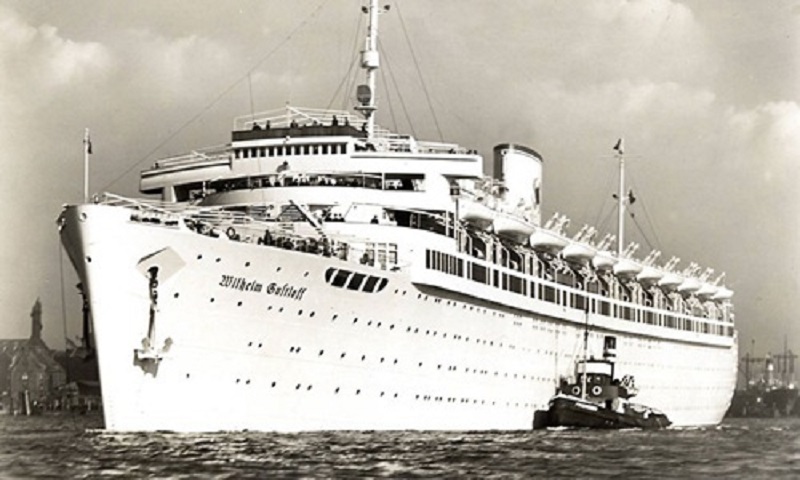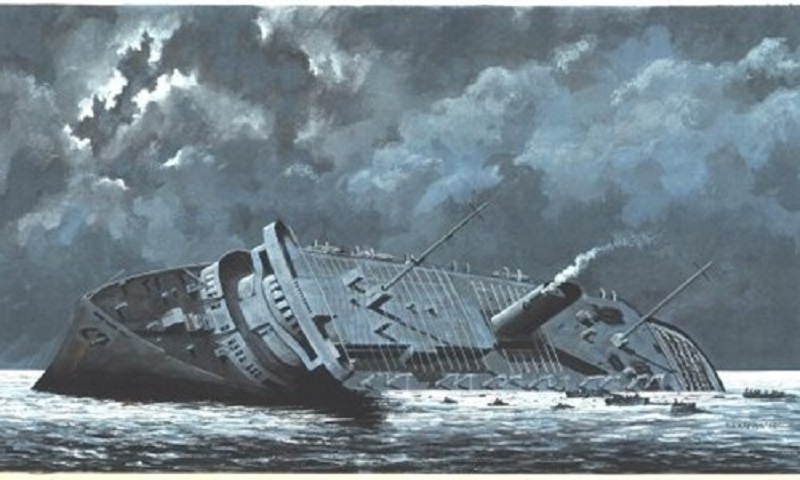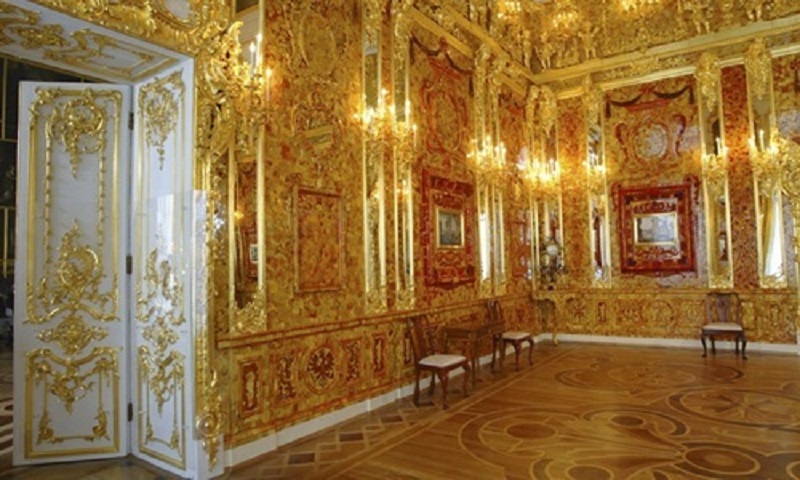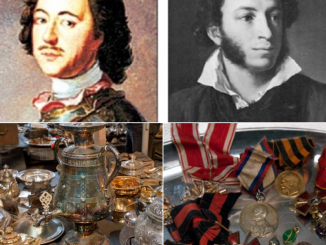The Nazi cruise ship Wilhelm Gustloff sunk during World War II was said to be carrying 64 chests of gold or the Amber Room, but the story remains unclear to this day.

The Nazi Wilhelm Gustloff cruise ship. Photo: eutopress
On January 30, 1945, three torpedoes launched from the Soviet S-13 submarine sank the Nazi tourist ship Wilhelm Gustloff while it was carrying people and Nazi soldiers fleeing from Gdniya, at that time called Gotenhafen, a city in East Prussia.
More than 9,300 people died in the attack. This is considered the ship sinking with the greatest loss of life in maritime history, according to International Business Times.
Dubbed “Hitler’s Titanic”, the Wilhelm Gustloff was a ship belonging to the Nazi Germany’s Strength Through Joy entertainment agency. Workers loyal to the Nazi Labor Front were often rewarded with cruises on this ship to Spain and Norway. During World War II, the Wilhelm Gustloff was requisitioned as a hospital ship and to transport Nazi submariners.
Decades after the Wilhelm Gustloff disaster, rumors began to appear about a secret cargo on the ship when it sank. Mr. Heinz Schoen, assistant treasurer of the Wilhelm Gustloff ship, who was lucky to survive, wrote many books about the sinking of the ship, in which one book mentioned the trunks that were transferred onto the ship before it departed.
The Wilhelm Gustloff when it was sunk. Illustration photo: wilhelmgustloff.com
While working as a diver in Germany in the late 1980s, Philip Sayers, author of the book “Batic Gold,” met Rudi Lange, a radio technician on the Wilhelm Gustloff, who confirmed it firsthand. saw the trunks being loaded onto the ship.
“He told me the story of this shipwreck and it sounded a lot like the sinking of the Titanic. He had to find a way to survive in the middle of the ocean and swam for a long time around dead bodies and dying people. He She burst into tears as memories of the victims and the barely alive children came back,” Sayers said.
“He explained to me that on the night the Wilhelm Gustloff departed, a convoy of trucks loaded with goods appeared at the harbor as the ship was preparing to depart and he witnessed a group of Nazi soldiers carrying small trunks. but weighed heavily on the wharf,” Sayers reported.
Inferences and speculations about the contents of the above mentioned chests still persist to this day. Mr. Schoen believes they contain the walls of the famous Amber Room, which was looted by Nazi soldiers from the Catherine Palace during the siege of St. Petersburg. Fascist soldiers are said to have brought the Amber Room, worth about $400 million, to the city of Koenigsberg (later renamed Kaliningrad) located near Gdniya.
However, Rudi Lange thinks the above hypothesis is doubtful because the trunks he saw were small in size. Furthermore, Lange also claimed he had discovered what the trunks actually contained.
Lange revealed to Sayers that he met one of the Nazi soldiers who transported the mysterious trunks onto the ship at a memorial event for the victims of the sinking of the Cap Arcona held in the town of Neustadt, Germany, in 1972. Cap Arcona was a Nazi transport ship that was sunk by British air force fighters in May 1945, killing about 5,000 people on board, mainly prisoners from concentration camps in Germany.
“Those trunks did not contain the walls of the Amber Room. The soldier said he had transferred 64 trunks containing gold bars from the Nazi Reichsbank Central Bank in Koenigsberg onto the ship Wilhelm Gustloff,” Lange told Sayers. The estimated value of these gold chests is more than 125 million USD, calculated at current prices.
The soldier said that the gold chests were placed in a special suite on the Wilhelm Gustloff that was reserved only for Hitler. According to the plan, people would then transfer them to small boats and take them to a secret place, but unfortunately, Wilhelm Gustloff was sunk.
However, some experts do not believe the rumors about the treasure on the Wilhelm Gustloff ship.
American reporter Cathryn J. Prince interviewed many survivors of the Wilhelm Gustloff sinking disaster to write the book “Death in the Baltic: The sinking of the Wilhelm Gustloff during World War II” (Death in the Baltic: The World War II Sinking of the Wilhelm Gustloff).
“None of the survivors I spoke to nor any documents gave a description of the trunks being transported on board the ship. I was in contact with people who worked on the Wilhelm Gustloff before their departure. received refugees but they said they didn’t see any boxes. Every centimeter on the ship was packed with people,” Prince described.
Regarding the hypothesis that the Amber Room was brought on board the ship, Prince shared: “Historians I spoke with said that such a treasure was more likely to be hidden in mountain caves or mines.” . Prince said there was no way the Nazis would entrust such valuable cargo to a cruise ship carrying desperate refugees.
The Amber Room was recreated in Russia. Photo: Reuters
To test the rumors, Sayers and a fellow diver dived into the sea to survey the wreck of the Wilhelm Gustloff in 1988. The ship was located at a depth of 50 m and about 60 km from the Polish coast. However, when they arrived, the two discovered that they were not the first people to find the shipwreck.
“Apparently someone dived down here and ransacked and destroyed the wreck. They may have wanted to search for the Amber Room,” Sayers said.
According to Sayers, the Soviets destroyed the wreck to eliminate the risk of other ships colliding with it. The remaining pieces of the Wilhelm Gustloff ship lie in piles scattered on the seabed. Some parts of the ship looked like they had exploded.
“You could clearly see holes through the ship’s hull and parts where people had to use high-powered cutters. It looked to me as if the ship had exploded due to explosives being placed,” Sayers said.
Sayers and his colleagues removed a blackened window from the ship’s side in the medical room to bring it ashore. However, when they returned to the port in the city of Kiel, Germany, they were arrested and charged with stealing the wreck.
Finally, they were released and soon after, at the request of the German government, the Polish authorities established a no-trespass zone around the wreck site of the Wilhelm Gustloff, and considered this place a cemetery. war. Divers are only allowed to access the area with a special permit.
Mike Boring, the diver whom reporter Prince spoke to, dived to survey the wreck of the Wilhelm Gustloff in 2003. He confirmed that the ship had been cleaned up. But what is most puzzling is that there are no traces of human remains.
Legends about where Nazi Germany’s secret gold treasures were hidden still fascinate many adventurers. For Prince, the tragedy of the Wilhelm Gustloff and the mysterious fate of the Amber Room will be topics that will continue to attract rumors, perhaps for a long time to come.




